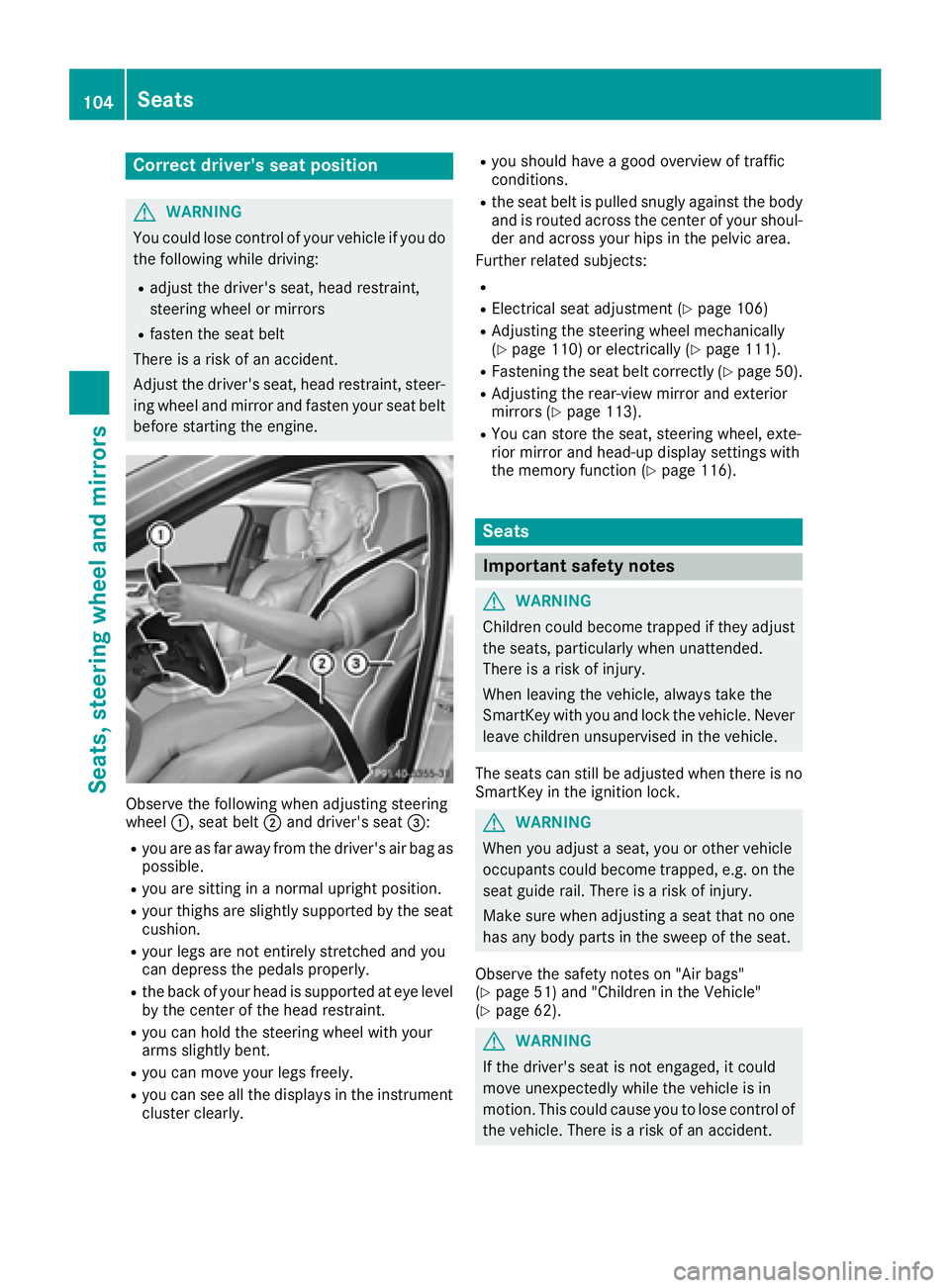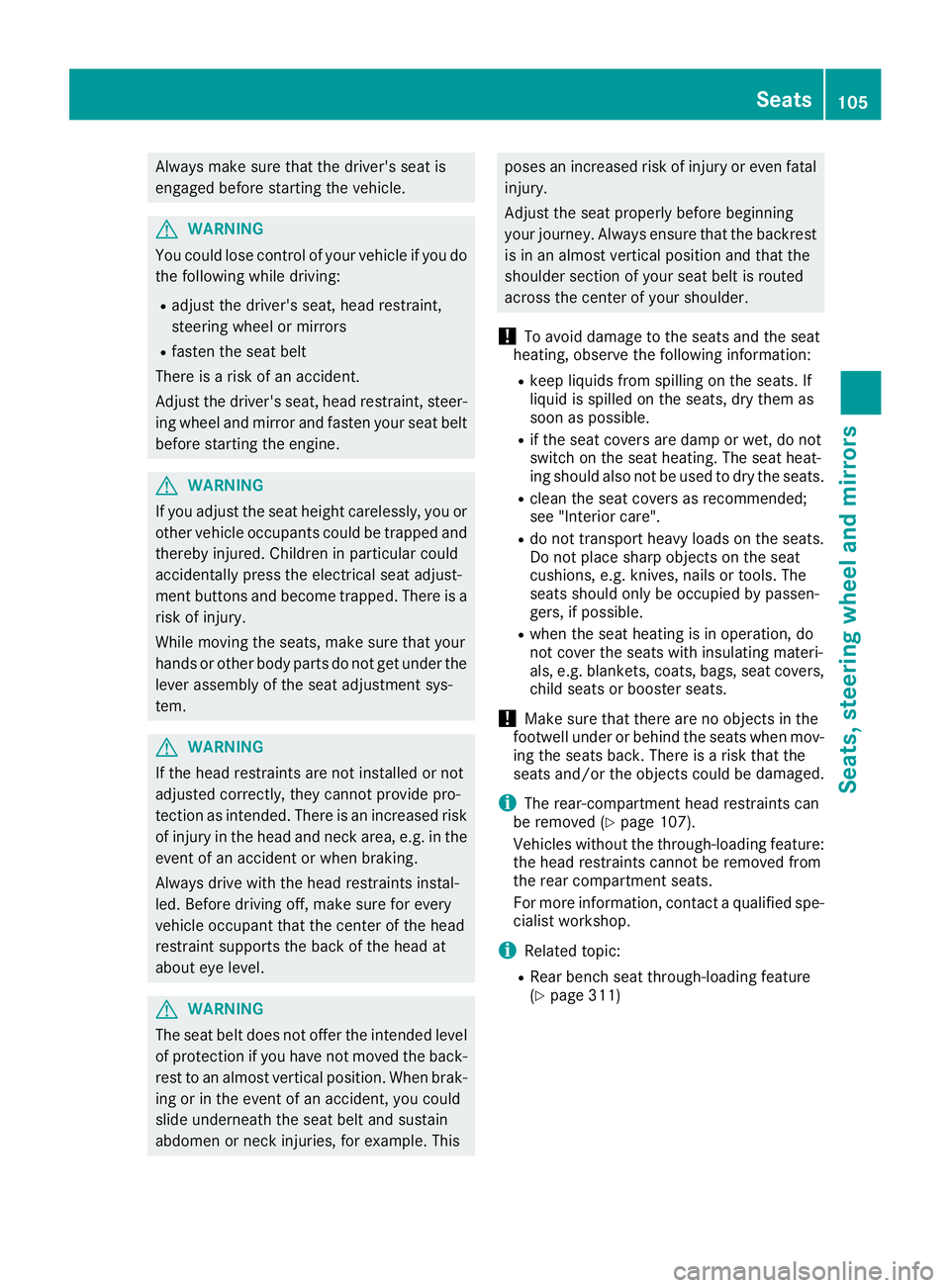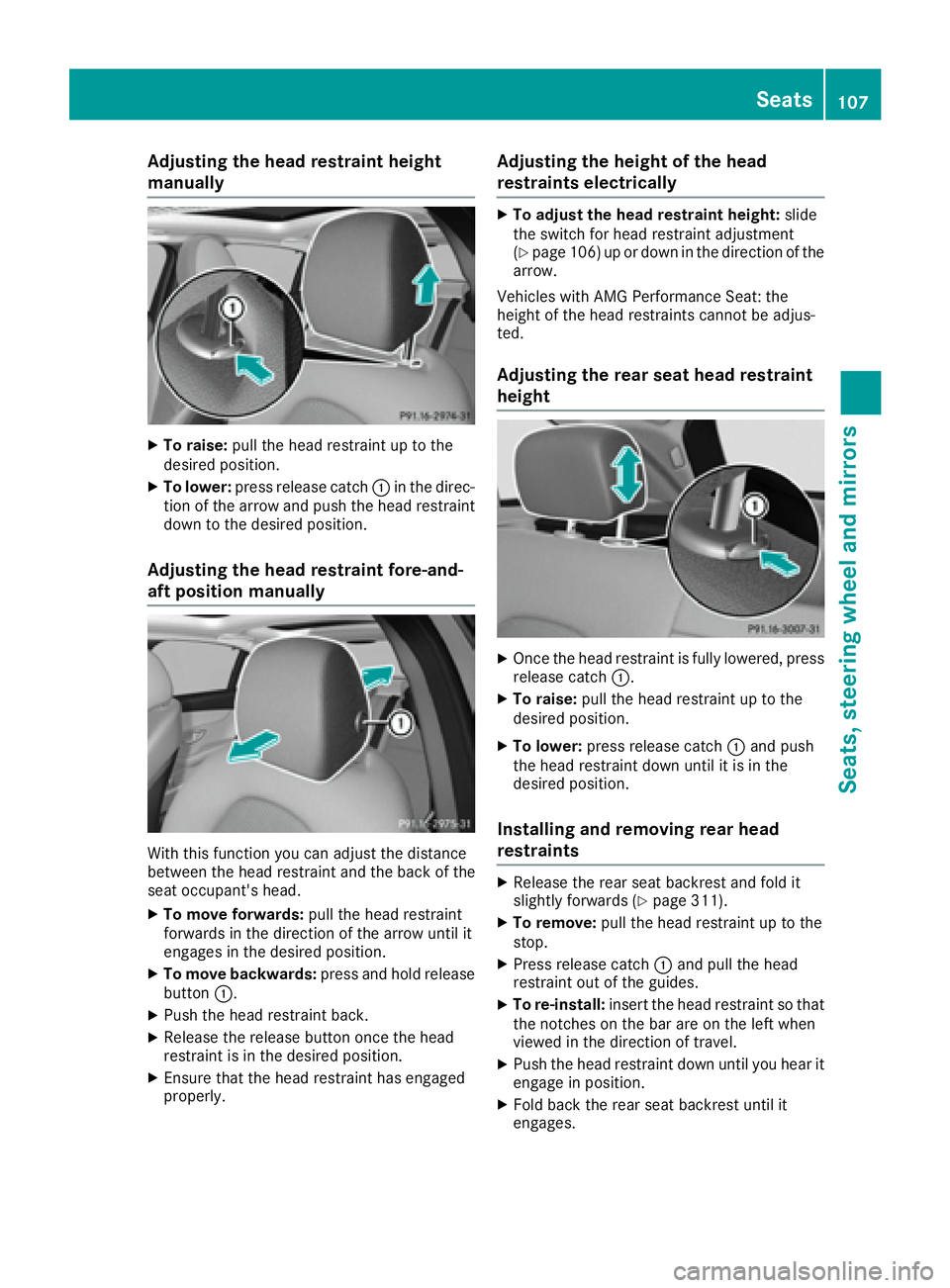2016 MERCEDES-BENZ C CLASS steering wheel
[x] Cancel search: steering wheelPage 77 of 398

G WARNING
If you deactivate ESP ®
, ESP ®
no longer sta-
bilizes the vehicle. There is an increased risk
of skidding and an accident.
Only deactivate ESP ®
in the situations descri-
bed in the following.
! Avoid spinning the driven wheels for an
extended period with ESP ®
deactivated. You
could otherwise damage the drivetrain.
In the following situations, it may be better to
activate SPORT handling mode or deactivate
ESP ®
: R
when using snow chains R
in deep snow R
on sand or gravel R
on specially designated roads when the vehi-
cle's own oversteering and understeering
characteristics are desired
Driving in SPORT handling mode or without
ESP ®
requires an extremely qualified and expe-
rienced driver.
i Activate ESP ®
as soon as the situations
described above no longer apply. ESP ®
will
otherwise not be able to stabilize the vehicle if
the vehicle starts to skid or a wheel starts to
spin.
Deactivating/activating ESP ®
X
To activate SPORT handling mode: briefly
press button �C .
The �t SPORT handling mode warning
lamp in the instrument cluster lights up. The SPORT handling mode
message appears in
the multifunction display. X
To deactivate SPORT handling mode:
briefly press button �C .
The �t SPORT handling mode warning
lamp in the instrument cluster goes out. X
To deactivate ESP ®
: press button �C until
the �
Page 81 of 398

This steering assistance is provided in particular
if: R
both right wheels or both left wheels are on a
wet or slippery road surface when you brake. R
the vehicle starts to skid.
Important safety notes
i Observe the "Important safety notes" sec-
tion ( Y
page 68).
No steering support is provided from STEER
CONTROL, if: R
ESP ®
is deactivatedR
ESP ®
is malfunctioning.R
the lighting is faulty.
If ESP ®
is malfunctioning, you will be assisted
further by the electrical power steering.
Protection against theft
Immobilizer The immobilizer prevents your vehicle from
being started without the correct SmartKey. X
To activate with the SmartKey: remove the
SmartKey from the ignition lock. X
To activate with KEYLESS-GO start-func-
tion or KEYLESS-GO: switch the ignition off
and open the driver's door. X
To deactivate: switch on the ignition.
When leaving the vehicle, always take the
SmartKey with you and lock the vehicle. Anyone
can start the engine if a valid SmartKey has been
left inside the vehicle.
i The immobilizer is always deactivated when
you start the engine.
In the event that the engine cannot be started
(yet the vehicle's battery is charged), the sys-
tem is not operational. Contact an authorized
Mercedes-Benz Center or call
1-800-FOR-MERCedes (in the USA) or
1-800-387-0100 (in Canada). ATA (anti-theft alarm system) X
To arm: lock the vehicle with the SmartKey or
KEYLESS-GO.
Indicator lamp �C flashes. The alarm system
is armed after approximately 10 seconds. X
To disarm: unlock the vehicle with the Smart-
Key or KEYLESS-GO.
or X
Insert the SmartKey into the ignition lock.
A visual and audible alarm is triggered if the
alarm system is armed and you open: R
a door R
the vehicle with the mechanical key R
the trunk lid R
the hood X
To turn the alarm off with the SmartKey:
press the �6 or �7 button on the Smart-
Key.
The alarm is switched off.
or X
Vehicles with KEYLESS-GO start-function
or KEYLESS-GO: remove the Start/Stop but-
ton from the ignition lock ( Y
page 146).X
Insert the SmartKey into the ignition lock.
The alarm is switched off. X
To stop the alarm using KEYLESS-GO:
grasp the outside door handle. The SmartKey
must be outside the vehicle.
The alarm is switched off.
or X
Press the Start/Stop button on the dash-
board. The SmartKey must be inside the vehi-
cle.
The alarm is switched off.
The alarm is not switched off, even if you close
the open door that triggered it, for example.Protection against theft 79
Safety Z
Page 106 of 398

Correct driver's seat position
G WARNING
You could lose control of your vehicle if you do
the following while driving: R
adjust the driver's seat, head restraint,
steering wheel or mirrors R
fasten the seat belt
There is a risk of an accident.
Adjust the driver's seat, head restraint, steer-
ing wheel and mirror and fasten your seat belt
before starting the engine.
Observe the following when adjusting steering
wheel �C , seat belt �D and driver's seat �
Page 107 of 398

Always make sure that the driver's seat is
engaged before starting the vehicle.
G WARNING
You could lose control of your vehicle if you do
the following while driving: R
adjust the driver's seat, head restraint,
steering wheel or mirrors R
fasten the seat belt
There is a risk of an accident.
Adjust the driver's seat, head restraint, steer-
ing wheel and mirror and fasten your seat belt
before starting the engine.
G WARNING
If you adjust the seat height carelessly, you or
other vehicle occupants could be trapped and
thereby injured. Children in particular could
accidentally press the electrical seat adjust-
ment buttons and become trapped. There is a
risk of injury.
While moving the seats, make sure that your
hands or other body parts do not get under the
lever assembly of the seat adjustment sys-
tem.
G WARNING
If the head restraints are not installed or not
adjusted correctly, they cannot provide pro-
tection as intended. There is an increased risk
of injury in the head and neck area, e.g. in the
event of an accident or when braking.
Always drive with the head restraints instal-
led. Before driving off, make sure for every
vehicle occupant that the center of the head
restraint supports the back of the head at
about eye level.
G WARNING
The seat belt does not offer the intended level
of protection if you have not moved the back-
rest to an almost vertical position. When brak-
ing or in the event of an accident, you could
slide underneath the seat belt and sustain
abdomen or neck injuries, for example. This poses an increased risk of injury or even fatal
injury.
Adjust the seat properly before beginning
your journey. Always ensure that the backrest
is in an almost vertical position and that the
shoulder section of your seat belt is routed
across the center of your shoulder.
! To avoid damage to the seats and the seat
heating, observe the following information: R
keep liquids from spilling on the seats. If
liquid is spilled on the seats, dry them as
soon as possible. R
if the seat covers are damp or wet, do not
switch on the seat heating. The seat heat-
ing should also not be used to dry the seats. R
clean the seat covers as recommended;
see "Interior care". R
do not transport heavy loads on the seats.
Do not place sharp objects on the seat
cushions, e.g. knives, nails or tools. The
seats should only be occupied by passen-
gers, if possible. R
when the seat heating is in operation, do
not cover the seats with insulating materi-
als, e.g. blankets, coats, bags, seat covers,
child seats or booster seats.
! Make sure that there are no objects in the
footwell under or behind the seats when mov-
ing the seats back. There is a risk that the
seats and/or the objects could be dama ged.
i The rear-compartment head restraints can
be removed ( Y
page 107).
Vehicles without the through-loading feature:
the head restraints cannot be removed from
the rear compartment seats.
For more information, contact a qualified spe-
cialist workshop.
i Related topic: R
Rear bench seat through-loading feature
( Y
page 311) Seats 105
Seats, steering wheel an d mirrors Z
Page 109 of 398

Adjusting the head restraint height
ma nually X
To raise: pull th e head restrain t up to th e
desired position .X
To lower : press release catch �C in th e direc -
tion of th e arrow and push th e head restrain t
down to th e desired position .
Adjusting the head restraint fore-and-
aft position ma nually
Wit h this function you can adjust th e distanc e
between th e head restrain t and th e bac k of th e
seat occupant's head .X
To mov e forwards : pull th e head restrain t
forward s in th e direction of th e arrow until it
engage s in th e desired position .X
To mov e backwards : press and hold release
butto n �C .X
Push th e head restrain t back.X
Releas e th e release butto n once th e head
restrain t is in th e desired position .X
Ensur e that th e head restrain t has engage d
properly. Adjusting the height of the head
restraints elect ri cally X
To adjust th e hea d restrain t height : slid e
th e switch for head restrain t adjustmen t
( Y
page 106) up or down in th e direction of th e
arrow.
Vehicles wit h AM G Performance Seat: th e
height of th e head restraints canno t be adjus-
ted.
Adjusting the rear seat head restraint
height X
Once th e head restrain t is fully lowered, press
release catch �C . X
To raise: pull th e head restrain t up to th e
desired position . X
To lower : press release catch �C and push
th e head restrain t down until it is in th e
desired position .
Installing and removing rear head
restraints X
Releas e th e rear seat backrest and fol d it
slightly forward s ( Y
page 311).X
To remove: pull th e head restrain t up to th e
stop. X
Press release catch �C and pull th e head
restrain t out of th e guides.X
To re-install : insert th e head restrain t so that
th e notches on th e bar are on th e lef t when
viewed in th e direction of travel .X
Push th e head restrain t down until you hear it
engage in position .X
Fold bac k th e rear seat backrest until it
engages. Seats 107
Seats, steering wheel and mirrors Z
Page 111 of 398

Switching the seat ventilation on/off
The three blue indicator lamps in the buttons
indicate the ventilation level you have selected. X
Turn the SmartKey to position 1 or 2 in the
ignition lock ( Y
page 146).X
To switch on: press button �C repeatedly
until the desired ventilation level is set. X
To switch off: press button �C repeatedly
until all the indicator lamps go out.
i If the battery voltage is too low, the seat
ventilation may switch off.
i You can open the side windows and the slid-
ing sunroof using the "Convenience opening"
feature ( Y
page 96). The seat ventilation of
the driver's seat automatically switches to the
highest level.
i When the vehicle is stationary, the fan
speed can be reduced automatically. This
reduces the noises of the seat ventilation. Seats 109
Seats, steering wheel and mirrors Z
Page 112 of 398

Problems with the seat heating or seat ventilation Problem
Possible causes/consequences and �P Solutions
Seat heating or seat ven-
tilation has been
switched off prematurely
or cannot be switched
on. The on-board voltage is too low because too many electrical consum-
ers are switched on. X
Switch off electrical consumers that you do not need, such as the
rear window defroster or interior lighting.
Once the battery is sufficiently charged, the seat heating or seat
ventilation can be switched back on manually.
Steering wheel
Important safety notes
G WARNING
You could lose control of your vehicle if you do
the following while driving: R
adjust the driver's seat, head restraint,
steering wheel or mirrors R
fasten the seat belt
There is a risk of an accident.
Adjust the driver's seat, head restraint, steer-
ing wheel and mirror and fasten your seat belt
before starting the engine.
G WARNING
Children could injure themselves if they
adjust the steering wheel. There is a risk of
injury.
When leaving the vehicle, always take the
SmartKey with you and lock the vehicle. Never
leave children unsupervised in the vehicle.
The electrically adjustable steering wheel can
still be adjusted when there is no key in the igni-
tion lock. Adjusting the steering wheel man-
ually
�C
Release lever �D
To adjust the steering wheel height �
Page 113 of 398

Adjusting the steering wheel elect ri -
cally
�C
To adjust th e steering whee l position (fore-
and-af t adjustment)�D
To adjust th e steering whee l height
i Further relate d subjects :R
EASY-ENTRY/EXIT feature ( Y
page 112)R
Storing setting s ( Y
page 116)R
Operating th e on-board computer
( Y
page 236).
Steering wheel heating
Switching on/off
X
Turn th e SmartKey to position 2 in th e ignition
loc k ( Y
page 146).X
To switch on/off: tur n th e lever in th e direc -
tion of arrow �C or �D .
Indicato r lamp �